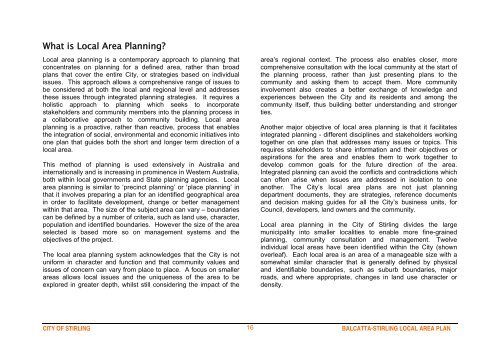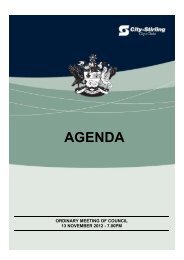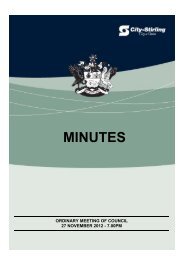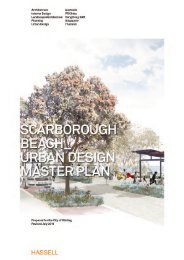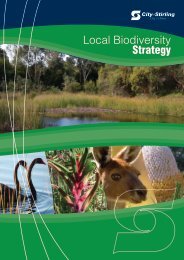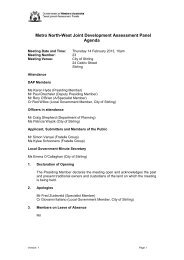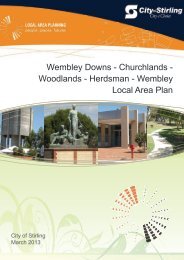Balcatta Stirling Local Area Plan - City of Stirling
Balcatta Stirling Local Area Plan - City of Stirling
Balcatta Stirling Local Area Plan - City of Stirling
You also want an ePaper? Increase the reach of your titles
YUMPU automatically turns print PDFs into web optimized ePapers that Google loves.
What is <strong>Local</strong> <strong>Area</strong> <strong>Plan</strong>ning?<br />
<strong>Local</strong> area planning is a contemporary approach to planning that<br />
concentrates on planning for a defined area, rather than broad<br />
plans that cover the entire <strong>City</strong>, or strategies based on individual<br />
issues. This approach allows a comprehensive range <strong>of</strong> issues to<br />
be considered at both the local and regional level and addresses<br />
these issues through integrated planning strategies. It requires a<br />
holistic approach to planning which seeks to incorporate<br />
stakeholders and community members into the planning process in<br />
a collaborative approach to community building. <strong>Local</strong> area<br />
planning is a proactive, rather than reactive, process that enables<br />
the integration <strong>of</strong> social, environmental and economic initiatives into<br />
one plan that guides both the short and longer term direction <strong>of</strong> a<br />
local area.<br />
This method <strong>of</strong> planning is used extensively in Australia and<br />
internationally and is increasing in prominence in Western Australia,<br />
both within local governments and State planning agencies. <strong>Local</strong><br />
area planning is similar to ‘precinct planning’ or ‘place planning’ in<br />
that it involves preparing a plan for an identified geographical area<br />
in order to facilitate development, change or better management<br />
within that area. The size <strong>of</strong> the subject area can vary – boundaries<br />
can be defined by a number <strong>of</strong> criteria, such as land use, character,<br />
population and identified boundaries. However the size <strong>of</strong> the area<br />
selected is based more so on management systems and the<br />
objectives <strong>of</strong> the project.<br />
The local area planning system acknowledges that the <strong>City</strong> is not<br />
uniform in character and function and that community values and<br />
issues <strong>of</strong> concern can vary from place to place. A focus on smaller<br />
areas allows local issues and the uniqueness <strong>of</strong> the area to be<br />
explored in greater depth, whilst still considering the impact <strong>of</strong> the<br />
area’s regional context. The process also enables closer, more<br />
comprehensive consultation with the local community at the start <strong>of</strong><br />
the planning process, rather than just presenting plans to the<br />
community and asking them to accept them. More community<br />
involvement also creates a better exchange <strong>of</strong> knowledge and<br />
experiences between the <strong>City</strong> and its residents and among the<br />
community itself, thus building better understanding and stronger<br />
ties.<br />
Another major objective <strong>of</strong> local area planning is that it facilitates<br />
integrated planning - different disciplines and stakeholders working<br />
together on one plan that addresses many issues or topics. This<br />
requires stakeholders to share information and their objectives or<br />
aspirations for the area and enables them to work together to<br />
develop common goals for the future direction <strong>of</strong> the area.<br />
Integrated planning can avoid the conflicts and contradictions which<br />
can <strong>of</strong>ten arise when issues are addressed in isolation to one<br />
another. The <strong>City</strong>’s local area plans are not just planning<br />
department documents, they are strategies, reference documents<br />
and decision making guides for all the <strong>City</strong>’s business units, for<br />
Council, developers, land owners and the community.<br />
<strong>Local</strong> area planning in the <strong>City</strong> <strong>of</strong> <strong>Stirling</strong> divides the large<br />
municipality into smaller localities to enable more fine-grained<br />
planning, community consultation and management. Twelve<br />
individual local areas have been identified within the <strong>City</strong> (shown<br />
overleaf). Each local area is an area <strong>of</strong> a manageable size with a<br />
somewhat similar character that is generally defined by physical<br />
and identifiable boundaries, such as suburb boundaries, major<br />
roads, and where appropriate, changes in land use character or<br />
density.<br />
CITY OF STIRLING 16<br />
BALCATTA-STIRLING LOCAL AREA PLAN


